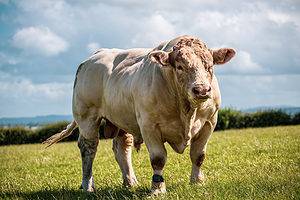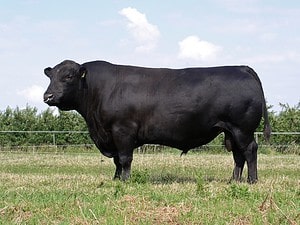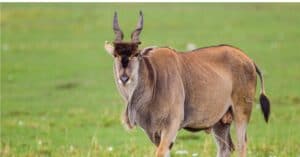Picture your typical dairy cow’s daily routine. According to Michigan State University, it goes something like this: grazing for 3 to 5 hours, mooing at will, resting for 12 to 14 hours, standing or walking for 2 to 3 hours, drinking water for 30 minutes, and perhaps even some tail-flicking at pesky flies. Given the rigors of this schedule, it’s a wonder when and how they ever get any shut-eye. But, our bovine friends find a way to get their z’s. Six ways, to be exact. Join us as we graze our eye upon the slumbering ungulates of the pasture.
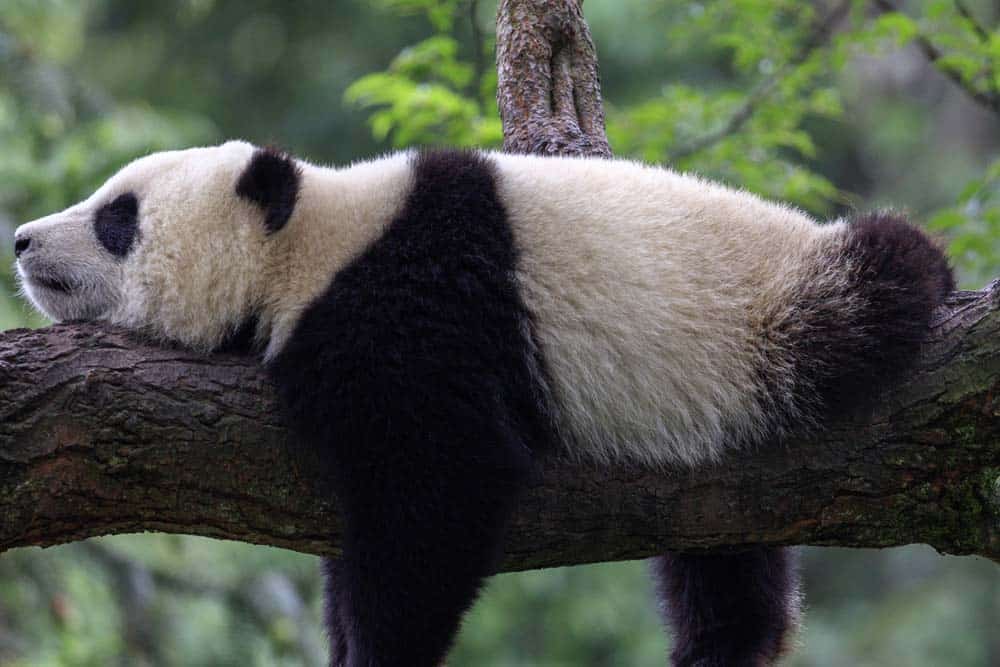
Holstein cows and giant pandas share a black-and-white coloration, as well as a need for good sleep—an average of about 10 hours per day of the stuff for pandas.
©clkraus/Shutterstock.com
The Intricacies of Sleep: From Humans to Bovines
Sleep is more than just a respite from the day’s labor; it’s an intricate biological necessity that varies significantly from species to species. In this article, we’ll explore the nuances of sleep, particularly focusing on humans and cows, to understand how sleep impacts well-being, performance, and overall health.
Why Sleep Matters
Whether you’re a human, concerned with optimal cognitive functioning, or a cow, involved in dairy and beef production, sleep is fundamental. For humans, the standard recommendation is eight hours of sleep per night. In contrast, cows operate differently: their sleep needs and patterns directly affect their well-being and productivity. So let’s dive into the fascinating science of sleep cycles and see how they compare across species.
The Human Sleep Cycle: A Quick Overview
Sleep in humans is complex, typically comprising four to six cycles per night. Each cycle lasts between 70 and 120 minutes and consists of both non-rapid eye movement (NREM) and rapid eye movement (REM) stages:
- Stage 1 (NREM): A brief phase of drowsiness, marking the beginning of the sleep cycle. Breathing and heartbeat slow down.
- Stage 2 (NREM): A stage of light sleep where your bodily functions continue to slow. Roughly half of your total sleep time is spent here.
- Stage 3 (NREM): Also known as deep sleep or delta sleep, this is when the body gets its most significant rest and rejuvenation. It’s crucial for physical restoration and memory consolidation.
- Stage 4 (REM): The dreaming stage, featuring increased brain activity and eye movement. Important for cognitive and emotional balance.
- Cycle Resets: After REM, the cycle starts anew, usually four to six times throughout the night.
Factors such as age, recent sleep patterns, and even alcohol consumption can affect the duration of each sleep stage and the number of cycles one experiences.
Bovine Sleep: Less Time, Different Needs
For cows, sleep serves multiple functions, much like it does in humans. However, their sleep patterns are considerably shorter. According to studies, dairy cows sleep for about 3-4 hours per day, with only around 30 minutes of this in REM sleep. While the exact stages of bovine sleep are not as extensively researched, it’s clear that, like humans, cows also undergo different phases of sleep that contribute to their health and productivity.
Both cows and humans share the fundamental need for sleep, though their patterns and requirements differ significantly. While humans experience multiple cycles of NREM and REM sleep, amounting to a recommended eight hours per night, cows have more truncated sleep periods, often getting just 3 to 4 hours with less REM sleep. Despite these differences, the underlying importance of sleep as a cornerstone of well-being and performance remains consistent across the animal kingdom. Understanding and appreciating these biological variances not only evokes wonder but also enriches our comprehension of the diverse mechanisms that help various species thrive.

Around 75% of dairy farms use tie stalls, especially factory farms.
©Dieter Hawlan/iStock via Getty Images
1. The Comfort of Lying Down in Tie Stalls
It’s clear that not all sleep are of the same quality and depth. Happy cows love their casual sleeps, especially in a clean and well-appointed stall. In tie stall barns, where cows are milked in their individual stalls and usually go outside part of the day, the preference for lying down is strong. On average, cows in tie stalls lie down for about 10 to 12 hours daily. But why such extended lounging? The duration isn’t solely about seeking rest. In reality, these prolonged periods are a good measure of comfort and overall well-being for the cows. Studies indicate that longer lying times usually equate to improved welfare, reduced stress, and higher productivity—attributes crucial for both dairy and beef cattle.
The nitty-gritty details of lying bouts also apply here. On average, cows in tie stalls divide their day into around 9 to 11 lying bouts, which last between 60 and 99 minutes each. These serve as refreshing intervals that let cows transition from one activity to another, such as eating or socializing, without sapping their energy.
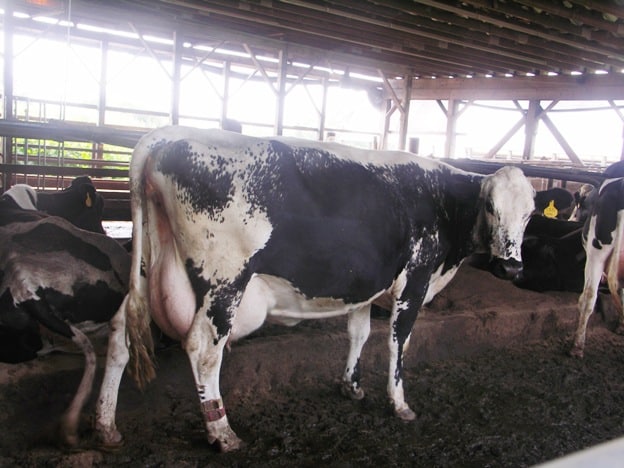
By creating alleyways or lanes between one area of the barn and another, free stalls provide a less restricted indoor environment for cows than do tie stalls.
©Vaarok_PublicDomain – License
2. Free Stalls: Choose Your Own Naps
Free stalls present a slightly different story. Unlike tie stalls, cows in free stall barns are not confined to individual stalls but can roam within pens and access various areas, such as their bedding and feeding stations. The duration of lying down is still in the ballpark of 10 to 12 hours per day, aligning closely with the numbers observed in tie stalls.
What sets free stalls apart is the element of choice. Cows can select from multiple stalls or rest areas, contributing to a sense of freedom. The quality of flooring can be especially consequential here. Comfortable flooring surfaces often result in cows lying down for longer stretches and getting up more frequently, suggesting less discomfort and perhaps a better quality of life.
To add nuance, the type of flooring can make a difference too. Cows lying on comfortable flooring tend to rest for longer periods and stand up more frequently, suggesting less discomfort and potentially better quality of life.

Grassland, nature’s all-purpose carpet and cow food buffet.
©Canetti/Shutterstock.com
3. Shut-Eye via Lying Down on Bedded Packs or Pasture
Switching gears, let’s talk about a different setting that you might encounter: bedded packs or pasture environments. While cows in tie stalls and free stalls lie down for about 10 to 12 hours a day, those on bedded packs or grazing in pastures may rest for slightly less time.
Why the difference? Well, pastures offer more than just a place to sleep. They provide an environment where cows can roam, graze, and engage in social activities, thereby reducing the total time spent lying down. Nevertheless, the quality of sleep doesn’t necessarily suffer. The natural ground cover, like grass and soil, can offer a level of comfort that some cows may prefer over artificial flooring, affecting how deep and restorative their sleep is. And such findings shouldn’t surprise experienced backcountry campers (once acclimated to the novel soundtrack of Nature, of course).
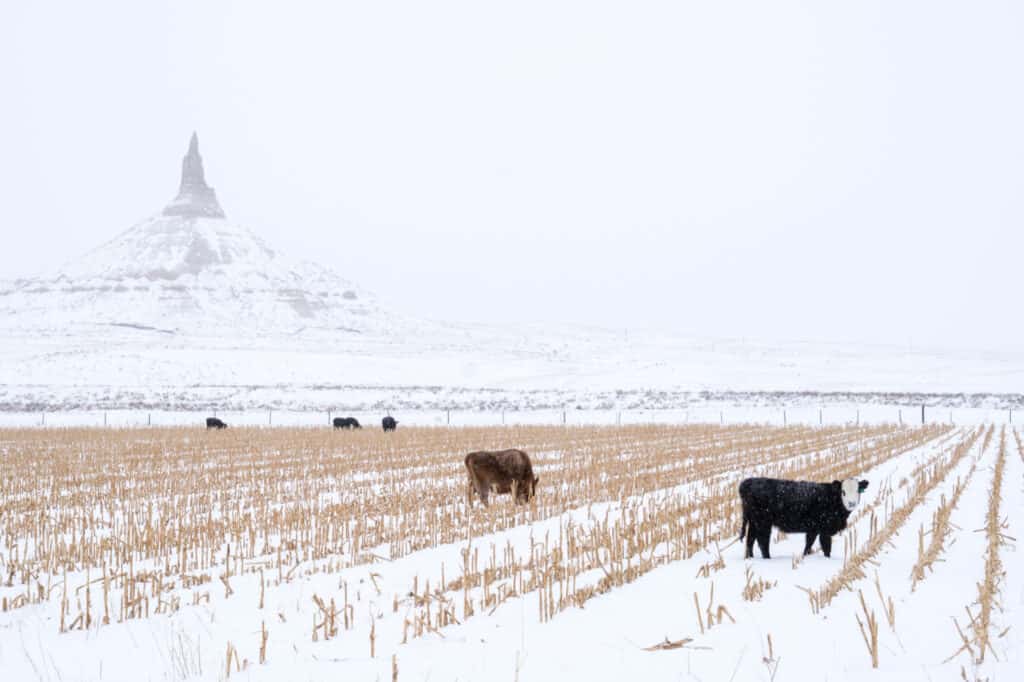
While cows appear to always be standing still, chewing over existence and grass, it may be that they are just sleep-standing.
©melissamn/Shutterstock.com
4. The Art of Dozing Off While Standing (Don’t Try at Home)
Have you ever been so tired you felt like you could sleep standing up? Cows can actually do just that! (Again, don’t try at home, while operating heavy machinery, or as you are reading this article.) While it’s not the deepest form of rest, cows can engage in light sleep while on their feet. This capability is particularly handy for survival in the wild, allowing them to be more alert to potential threats.
Cows aren’t the only champions of upright napping. Other large herbivores like horses and giraffes also share this remarkable ability. These animals enter a state of light sleep where the brain partially rests, but not to the point of deep sleep or REM cycles. It’s a fascinating adaptation that plays a crucial role in their lifestyle and survival strategies.
While there are a total of 17 animals that can sleep while standing (which you can enjoy reading about here), cows are reluctant members of this exclusive club. While capable of sleeping standing up, being the intelligent mammals they are, cows mostly choose to lie down.

The lie about is classic cow.
©PHILIPPE MONTIGNY/Shutterstock.com
5. The Peculiar Case of Shut-Eye by Lying Bout
Earlier, we touched on the concept of “lying bouts,” but let’s delve a little deeper. A typical cow breaks its rest into 9 to 11 separate lying bouts, each lasting from 60 to 99 minutes. But why this specific frequency and duration? Studies indicate that these lying bouts serve as crucial restorative periods, allowing cows to maintain a balance between physical exertion and rest.
The science supports the idea that longer lying bouts and more frequent transitions between lying and standing are generally signs of better well-being in cows. These findings are important not just for animal welfare but also for farmers aiming to optimize productivity. After all, a comfortable, happy cow is often a more productive one, be it in milk yields or overall health.

Out on the open range where the days and nights are less structured than in the barn, cows will take the opportunity to nap when it suits them.
©Bob Pool/Shutterstock.com
6. Pastoral Power Naps
Contrast this with the life of cows on pasture. Here, sleep is a more evenly dispersed affair, spread across both daytime and nighttime. The open fields and natural daylight provide opportunities for “power naps,” while the absence of artificial lighting and confined spaces allows for more flexibility in rest schedules.
Why does this pattern change indoors? In artificial environments, feeding and milking schedules, along with human activity, often dictate the cows’ routines. In the great outdoors, cows rely more on their natural circadian rhythms, which leads to a more balanced spread of rest and activity.
Old-School Sleep: How Cows Sleep Indoors at Night
When confined to indoor settings like barns, cows demonstrate a propensity to sleep more during nighttime hours. With fewer distractions and the absence of grazing opportunities, they take advantage of this quieter time to rest. Nighttime sleep indoors can last between 7 to 9 hours, sometimes stretching into the early morning.
Does this nocturnal tendency have broader implications? Certainly. For farmers, understanding these patterns can help with managing cows for optimal health and productivity. For instance, better lighting and noise control during the night can facilitate a more restful sleep for the cows, which in turn may enhance milk production and overall well-being.
The Bigger Picture: Why Sleep Matters
As we’ve seen, cows have various ways to catch their z’s, each with its own set of benefits and implications. Whether it’s lying down in tie stalls, standing up briefly for a doze, or luxuriating in a pasture, sleep plays a critical role in a cow’s life. Yet, mysteries remain. The full impact of these sleep patterns on milk yield and meat quality is still a subject of ongoing research.
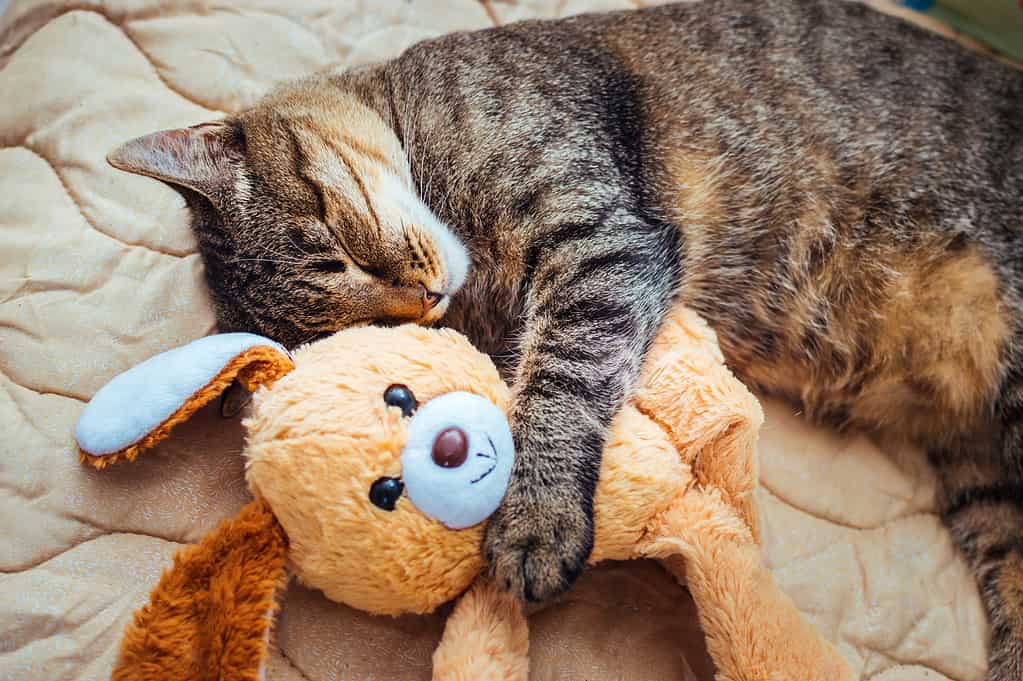
Aside from rats and gerbils, cats require the most sleep of any animal.
©anastas_/1391797125 via Getty Images
Comparative Sleep Needs
The sleep requirements for animals can differ dramatically from one species to another. While humans generally need at least 7 hours of sleep each night, some large land mammals get by with considerably less. African elephants sleep an average of two hours a day, and cows and horses sleep between three and four hours a day. According to another source, dairy cows sleep for approximately 3-4 hours per day, with only around 30 minutes of this in REM sleep. So we’re talking about sleep sleep here.
Here is a comparison of the average total sleep time for some animals:
| Animal | Percentage of Time Spent Sleeping | Hours/Day |
|---|---|---|
| African Elephant | 8.3% | 2 hours |
| Sheep | 16% | 3.8 hours |
| Asiatic Elephant | 16.4% | 3.9 hours |
| Cow | 16.4% | 3.9 hours |
| Goat | 22.1% | 5.3 hours |
| Human (elderly) | 22.9% | 5.5 hours |
| Gray Seal | 25.8% | 6.2 hours |
| Guppy (fish) | 29.1% | 7 hours |
| Pig | 32.6% | 7.8 hours |
| Human (adult) | 33.3% | 8 hours |
| Guinea Pig | 39.2% | 9.4 hours |
| Chimpanzee | 40.4% | 9.7 hours |
| Squirrel Monkey | 41.3% | 9.9 hours |
| European Hedgehog | 42.2% | 10.1 hours |
| Baboon | 42.9% | 10.3 hours |
| Star-nosed Mole | 42.9% | 10.3 hours |
| Bottle-nosed dolphin | 43.3% | 10.4 hours |
| Dog | 44.3% | 10.6 hours |
| Duck | 45% | 10.8 hours |
| Jaguar | 45% | 10.8 hours |
| Rabbit | 47.5% | 11.4 hours |
| Rhesus Monkey | 49.2% | 11.8 hours |
| Mouse | 50.3% | 12.1 hours |
| Cheetah | 50.6% | 12.1 hours |
| Cat | 50.6% | 12.1 hours |
| Rat | 52.4% | 12.6 hours |
| Gerbil | 54.4% | 13.1 hours |
Data sources:
- Connection Between Human and Animal Sleep
- Scientific Article on Sleep Patterns
- Are Your Cows Getting Enough Sleep?
- Animal Sleep Patterns
- Do Cows Need Beauty Rest?
- Do Cows Sleep Standing Up? (USDairy)
Conclusion
Our meandering journey brings us to this resounding truth: Understanding the intricacies of bovine slumber is not an academic luxury. Rather, it’s a compelling necessity for farmers, animal lovers, and anyone entranced by the multifaceted lives of these majestic creatures. In tracing the diverse ways cows sleep, we’ve gained valuable insights that could impact both farming practices and animal welfare. And beyond barn and pasture, we’ve gained a valuable point of comparison to help evaluate our own sleep habits—the good, the bad, and the udderly unconscionable.
The photo featured at the top of this post is © iStock.com/criene
Thank you for reading! Have some feedback for us? Contact the AZ Animals editorial team.



